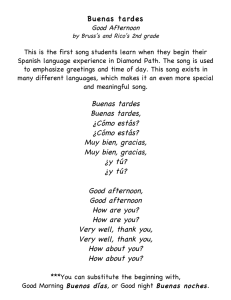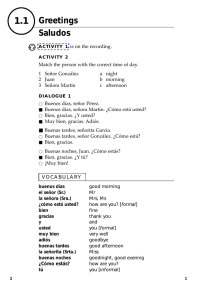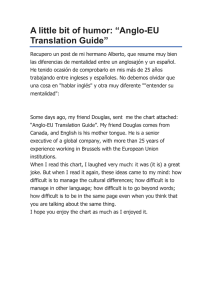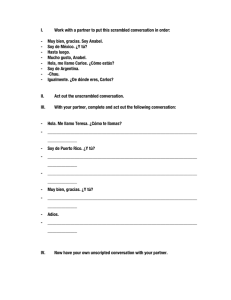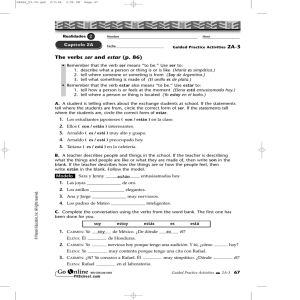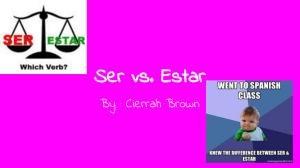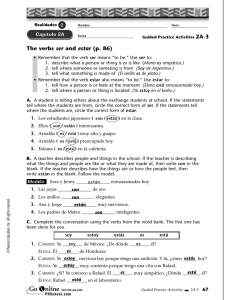Unit One - Spanish Mama
Anuncio
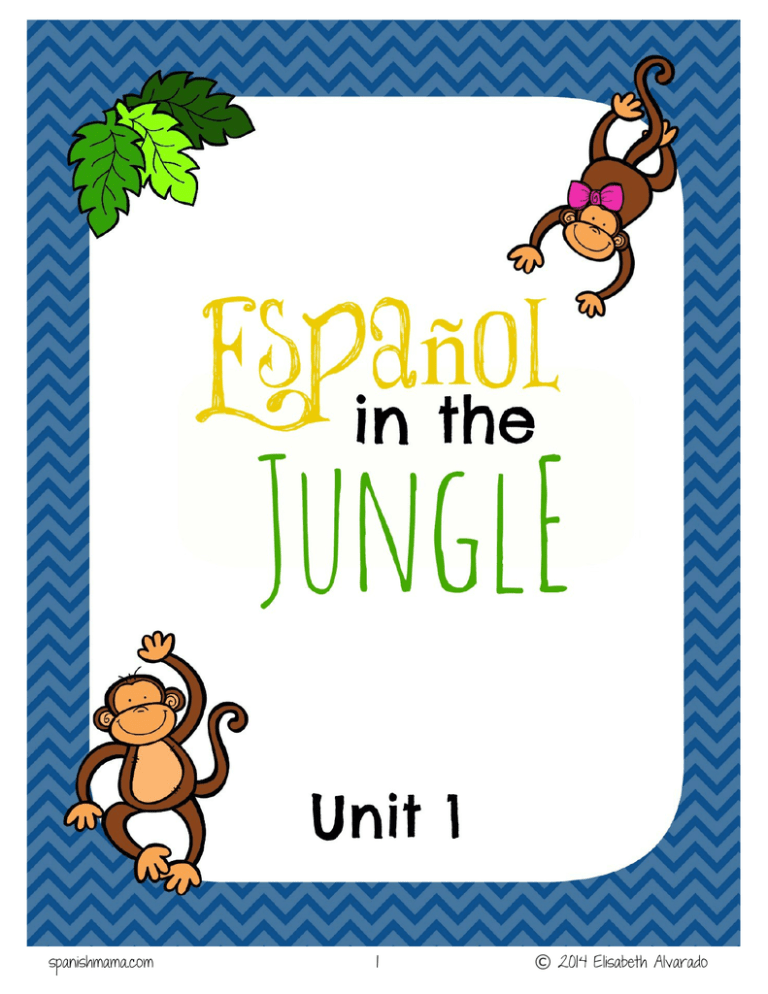
Unit One spanishmama.com 1 © 2014 Elisabeth Alvarado Unit One Teaching Unit 1: How to Begin… If you don’t speak Spanish! First, plan out how much to cover the first week. Set a small, reachable goal as you get started. Familiarize yourself with the words you will teach that week. Check spanishmama.com for pronunciation links. Practice until you feel confident. Introduce the first set of words. The students should only see the words after hearing them many times. Assign a motion or action to each word and focus on comprehending the word. For muy bien, they could make a happy, thumbs-up face, and for muy mal, make a sad face. Practice the song online. Even if they don’t understand all the words yet, the students (and you!) will be internalizing the pronunciation and cadence of the language. When the words are mastered, choose appropriate activities or games from the packet or online links. Unit One Could Look Like This: Week One: Teach hola, adios, levántate, siéntate Add to dictionaries, illustrate Make up motions for the words and act them out Reinforce with paper plates activity Do Q&A Flow with Pictures Play Pelota Caliente Teach buenos días, buenas tardes, buenas noches Add words to dictionaries and illustrate Practice song Week Three Week Two Review all vocabulary and the song Teach ¿Como esta/s?, muy bien, gracias, muy mal, and más o menos. Review all vocabulary and the song Do the ¿Como estas? Worksheet Play Ojos Cerrados Make and play Bingo Try the Matching Activity Again— be flexible and do what interests you and your students! Go at your own pace. There are many more online resources to supplement this unit at spanishmama.com. spanishmama.com 2 © 2014 Elisabeth Alvarado Unit One Vocabulary hola hello adiós good-bye levántate stand up siéntate sit down buenos días good morning buenas tardes good afternoon buenas noches good evening ¿Cómo estás? How are you? ¿Cómo está? How is he/she? (Muy) bien, gracias. (Very) well, thank you. (Muy) mal. (Very) bad. Más o menos. Okay. Song Buenos días, buenos días. ¿Cómo estás? ¿Cómo estás? Muy bien, gracias, muy bien, gracias. ¿Y tú, y tú? ¿Y tú, y tú? (To the tune of Are You Sleeping? ) spanishmama.com 3 © 2014 Elisabeth Alvarado Unit One Activities Make sad, happy, and “ok” faces on paper plates and ask the students directly ¿Como estas? They can practicing answering according the face they are holding up. Ask about their neighbor: ¿Como esta Sarah? Sing the Buenos Días song together. If it’s the afternoon or evening, change it to say “buenas tardes” or “buenas noches.” If you are new to Spanish, you can watch the other version online together: Buenos Días. Have your students begin their personal Spanish dictionaries. I have a free printable one available on spanishmama.com. Do the Q&A Flow with Pictures. Make it even more interesing by using the same flow with pictures of characters from a favorite book or movie! (¿Como esta Eyeore? ¿Nemo esta bien?) Games Ojos Cerrados Have the students close their eyes. Call out a vocabulary word. The students act it out with their eyes closed. If someone misses the answer, tap them quietly. They are out, but they get to open their eyes and help you “catch” the other students. This way they are still participating. The last student with closed eyes wins! Bingo Look at the vocabulary and draw a picture for each word in random squares. Try not to use any English words unless you have to! The teacher calls out the vocabulary words. The students cover the spot (use beans, counters, whatever you have!). 3-in-a-row wins! Pelota Caliente Chant ¿Co-mo, có-mo, có-mo, estás? while passing a ball or soft object around in a circle. Whoever is holding the ball when you get to the estas part answers the question: muy bien, muy mal, or más o menos. spanishmama.com 4 © 2014 Elisabeth Alvarado Unit One Q&A Flow with Pictures Fold the paper over so your students see the pictures and you can read the text in bold. Point to the picture of the girl. Teacher: ¿Está muy mal? (Is she feeling very badly?) Students: ¡No! Teacher: No, no está muy mal. ¿Está más o menos? (Is she feeling ok?) Students: ¡No! Teacher: No, no está más o menos. ¿Está muy bien? (Is she very well?) Students: ¡Sí! Teacher: ¿Cómo está ella? (How is she?) Students: ¡Muy bien! Teacher: ¡Sí, ella está muy bien! spanishmama.com 5 © 2014 Elisabeth Alvarado Unit One Q&A Flow with Pictures Fold the paper over so your students see the pictures and you can read the text in bold. Point to the picture of the boy. Teacher: ¿Está muy bien? (Is he very well?) Students: ¡No! Teacher: No, no está muy bien. ¿Está más ó menos? (Is he feeling ok?) Students: ¡No! Teacher: No, no está más o menos. ¿Está muy mal? (Is he feeling very badly?) Students: ¡Sí! Teacher: ¿Cómo está él? (How is he?) Students: ¡Muy mal! Teacher: ¡Sí, él está muy mal! spanishmama.com 6 © 2014 Elisabeth Alvarado Unit One ¿Cómo estás? Worksheet Dibuja (draw) to match the sentence in Spanish. ¿Cómo está Ana? ¿Cómo está Pablo? Ana está muy mal. Pablo está muy bien. ¿Cómo está Juan? ¿Cómo estás? Estoy Juan está más o menos. spanishmama.com 7 © 2014 Elisabeth Alvarado Unit One ¡Bingo! Dibuja (draw): muy bien siéntate buenas noches buenas días buenas tardes muy mal levántate más o menos adiós spanishmama.com 8 © 2014 Elisabeth Alvarado Unit One Matching Worksheet muy bien, gracias good evening buenas noches sit down levántate hello hola good-bye ¿Cómo estás? very bad adiós get up buenos días spanishmama.com ok muy mal good morning siéntate How are you? buenas tardes very well, thank you más o menos How is he/she? ¿Cómo está? good af ternoon 9 © 2014 Elisabeth Alvarado Unit One Matching Worksheet Answer Key muy bien, gracias good evening buenas noches sit down levántate hello hola good-bye ¿Cómo estás? very bad adiós get up buenos días very well, thank you muy mal good morning siéntate How are you? buenas tardes ok más o menos How is he/she? ¿Cómo está? good af ternoon spanishmama.com 10 © 2014 Elisabeth Alvarado Unit One Terms of Use This product is for use by the original downloader, for teaching purposes only. If you are not the original downloader, please visit www.spanishmama.com to download a personal copy. Redistributing, editing, selling, or posting this item (or any part thereof) is strictly prohibited without first gaining permission from the author. It is illegal to upload this file onto your blog, website, or to any sharing sites. Violations are subject to the penalties of the Digital Millennium Copyright Act. ©2014 Elisabeth Alvarado Credits Images from: http://www.teacherspayteachers.com/Store/Krista-Wallden Fonts: Janda Everyday Font, Kimberly Geswein Fonts LLC spanishmama.com 11 © 2014 Elisabeth Alvarado
